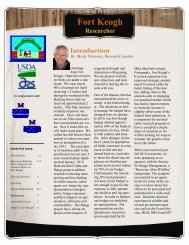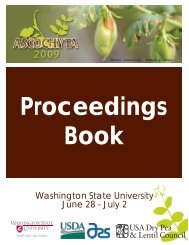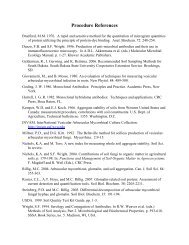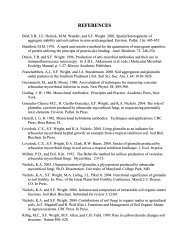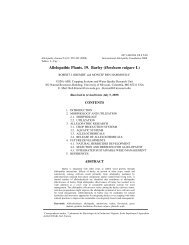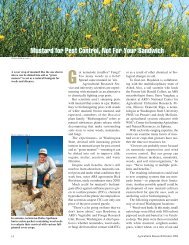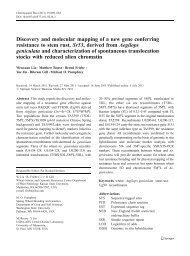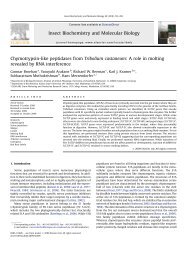- Page 1 and 2: UPDATE FOR A CATALOG OF THE CECIDOM
- Page 3 and 4: INTRODUCTION Cecidomyiidae are a la
- Page 5: 4 Postal makes this superfluous. Ru
- Page 9 and 10: 8 Anarete felti Pritchard 1951: 262
- Page 11 and 12: eschata. USA (Minnesota). Conarete
- Page 13 and 14: 12 Lestremia clivicola Hardy 1960:
- Page 15 and 16: *AMEDIELLA Amediella Jaschhof 2003b
- Page 17 and 18: 16 Aprionus bifurcatus Mamaev 1997b
- Page 19 and 20: 18 indicus. India (Uttar Pradesh).
- Page 21 and 22: 20 Aprionus subanalis Yukawa 1967:
- Page 23 and 24: 22 Österbybruk; HT; ♂; NHRS. abj
- Page 25 and 26: 24 Campylomyza globulifera Keilbach
- Page 27 and 28: Corinthomyia tumida Felt 1913c: 197
- Page 29 and 30: 28 *Heterogenella biradiata Mamaev
- Page 31 and 32: 30 Monardia abnormis Mamaev 1963a:
- Page 33 and 34: 32 articulosa. USA (Virginia, New H
- Page 35 and 36: 34 bifida. UK, Sweden, Latvia, Germ
- Page 37 and 38: & Jaschhof 2004b (New Zealand spp.)
- Page 39 and 40: 38 curta. Finland, Latvia, Lithuani
- Page 41 and 42: 40 Campylomyza modesta Felt 1907a:
- Page 43 and 44: 42 NZAC. ryukyuensis. Japan (Ryukyu
- Page 45 and 46: 44 Campyloneura Lengersdorf 1939: 1
- Page 47 and 48: 46 Research For.; HT; ♂; KUEC. fa
- Page 49 and 50: STROBLIELLA Strobliella Kieffer 189
- Page 51 and 52: anomala. France. anomala Kieffer 18
- Page 53 and 54: (review, Nearctic spp.), Spungis 19
- Page 55 and 56: Holoneurus strobilophilus Foote 195
- Page 57 and 58:
56 Camptomyia albidula Mamaev 1975d
- Page 59 and 60:
58 pallida. France. Camptomyia pall
- Page 61 and 62:
60 Holarctic, Oriental; 30 spp.; Po
- Page 63 and 64:
Coccopsis marginata Meijere 1901: 1
- Page 65 and 66:
tridentatus. France. Holoneurus tri
- Page 67 and 68:
66 Dicerura curva Borkent 1990: 576
- Page 69 and 70:
68 *nonsectaria. Russia (Far East).
- Page 71 and 72:
Palearctic; 1 sp.; Winnertziini. *f
- Page 73 and 74:
72 *stricta. Russia (Far East). Hap
- Page 75 and 76:
74 Holoneurus olschwangi Mamaev 199
- Page 77 and 78:
76 *nigella. Russia (Far East). Led
- Page 79 and 80:
Miastor americana Felt 1907d: 5. US
- Page 81 and 82:
lenticularis. Latvia. Neotetraneuro
- Page 83 and 84:
Asynapta nobilis Felt 1913f: 142. U
- Page 85 and 86:
84 Porricondyla sylvestris Felt 192
- Page 87 and 88:
86 Cecidomyia albitarsis Meigen 183
- Page 89 and 90:
Pseudepidosis lunaris Mamaev 1966:
- Page 91 and 92:
90 NKUM. *ramifera. Russia (Far Eas
- Page 93 and 94:
Stackelbergiella paradoxa Marikovsk
- Page 95 and 96:
Tutkowskia Fedotova & Perkovsky 200
- Page 97 and 98:
96 Winnertzia arizoniensis Felt 190
- Page 99 and 100:
98 Winnertzia kushkensis Mamaev 200
- Page 101 and 102:
Winnertzia solidaginis Felt 1907a:
- Page 103 and 104:
102 Acacidiplosis erupta Gagné 199
- Page 105 and 106:
Actilasioptera tumidifolium Gagné
- Page 107 and 108:
Neotropical; 1 sp.; Cecidomyiidi, L
- Page 109 and 110:
illata. Italy. Vitis vinifera (Vita
- Page 111 and 112:
ANISOSTEPHUS Anisostephus Rübsaame
- Page 113 and 114:
112 Rondaniella phorodontis Del Gue
- Page 115 and 116:
separated. *ampla. Russia (Far East
- Page 117 and 118:
or are known predators of Eriophyid
- Page 119 and 120:
118 Arthrocnodax saliciphilus Fedot
- Page 121 and 122:
120 artemisiae. USA (Arizona). Arte
- Page 123 and 124:
122 Asphondylia ceanothi Felt 1908b
- Page 125 and 126:
124 foliosa. USA (Arizona). Larrea
- Page 127 and 128:
126 Asphondylia lonchocarpi Möhn 1
- Page 129 and 130:
128 Asphondylia plaksinae Fedotova
- Page 131 and 132:
130 sidae. Colombia. Sida acuta; S.
- Page 133 and 134:
132 Misident as miki Wachtl in Webs
- Page 135 and 136:
134 carbonifera. Widespread Nearcti
- Page 137 and 138:
ATOLASIOPTERA Atolasioptera Möhn 1
- Page 139 and 140:
Baldratia Kieffer 1897c: 7. Type sp
- Page 141 and 142:
Western Palearctic; 4 spp.; Lasiopt
- Page 143 and 144:
142 Brachineura flabellata Fedotova
- Page 145 and 146:
Braueriella Kieffer 1896b: 4. Type
- Page 147 and 148:
BREPHOMETRA Pero Meinert 1870: 463,
- Page 149 and 150:
148 Asphondylia maytenuse Maia & Co
- Page 151 and 152:
CALLITRIDIPLOSIS Callitridiplosis K
- Page 153 and 154:
152 halostachysis. Kazakhstan. Halo
- Page 155 and 156:
154 Caryomyia glauciglobus Gagné 2
- Page 157 and 158:
156 Cecidomyia brevispatula Gagné
- Page 159 and 160:
158 nootkatensis. Canada (British C
- Page 161 and 162:
160 *achyrophoridis. Russia. Achyro
- Page 163 and 164:
162 corylicola. Japan (Honshu), Rep
- Page 165 and 166:
164 pratensis. USA (New York). Clin
- Page 167 and 168:
acaciae. Egypt. Acacia nilotica (Fa
- Page 169 and 170:
168 *allii. Kazakhstan. Allium trac
- Page 171 and 172:
170 Contarinia cerriperda Skuhravá
- Page 173 and 174:
172 Contarinia flavolinea Felt 1908
- Page 175 and 176:
174 kurenzovi. Russia (Far East). P
- Page 177 and 178:
176 Urunkhaïka, 60 km N Alekseyevk
- Page 179 and 180:
178 quercina. Widespread Europe. Qu
- Page 181 and 182:
180 Contarinia sorbi Kieffer 1896c:
- Page 183 and 184:
182 Contarinia virosa Fedotova 1996
- Page 185 and 186:
184 *insita. Russia (Far East). Coq
- Page 187 and 188:
CTENODACTYLOMYIA Ctenodactylomyia F
- Page 189 and 190:
DAPHNEPHILA Daphnephila Kieffer 190
- Page 191 and 192:
190 Perrisia alyssi Kieffer 1901d:
- Page 193 and 194:
192 HT; ♂; ZMAS. bupleuri. German
- Page 195 and 196:
194 cotini. Slovenia. Cotinus coggy
- Page 197 and 198:
196 fraxinifolia. USA (New York). F
- Page 199 and 200:
198 hygrophila. Widespread Europe.
- Page 201 and 202:
200 mariae. Spain. Astragalus lusit
- Page 203 and 204:
202 peinei. UK, Germany, Russia (Eu
- Page 205 and 206:
204 Neocerata rhodophaga Coquillett
- Page 207 and 208:
206 sibirica. Russia (Western Siber
- Page 209 and 210:
208 Dasineura theobromae Maia 2006b
- Page 211 and 212:
210 Dasyneura acerifolia Felt 1907c
- Page 213 and 214:
212 Kalodiplosis Felt 1915e: 229. T
- Page 215 and 216:
DIALERIA Dialeria Tavares 1918c: 78
- Page 217 and 218:
Didymomyia Rübsaamen 1912d: 216. T
- Page 219 and 220:
218 Domolasioptera curatellae Möhn
- Page 221 and 222:
Endaphis Kieffer 1896j: 383. Type s
- Page 223 and 224:
222 Epidiplosis bicornuta Li & Bu 2
- Page 225 and 226:
*chionochloae. New Zealand. Chionoc
- Page 227 and 228:
*FALCIFORMIDIPLOSIS Falciformidiplo
- Page 229 and 230:
228 insularis. USA (Illinois, New J
- Page 231 and 232:
230 Foveoladiplosis capitulifera Fe
- Page 233 and 234:
232 ZMAS. *mangiferae. India (Tamil
- Page 235 and 236:
supertribe is used here (see Append
- Page 237 and 238:
Guarephila Tavares 1909: 18. Type s
- Page 239 and 240:
238 Cecidomyiini. Halodiplosis appe
- Page 241 and 242:
240 Halodiplosis germinantis Fedoto
- Page 243 and 244:
242 Haloxylonophaga salsoliicola Ma
- Page 245 and 246:
244 Cecidomyia hudsoni Felt 1907a:
- Page 247 and 248:
HETEROCONTARINIA Heterocontarinia H
- Page 249 and 250:
Houardiella salicorniae Kieffer 191
- Page 251 and 252:
Iatrodiplosis Mani 1946: 222, missp
- Page 253 and 254:
Cecidomyia verruca Felt 1906a: 745,
- Page 255 and 256:
254 goebeliae. Kazakhstan. Goebelia
- Page 257 and 258:
256 Dichelomyia vaccinii Rübsaamen
- Page 259 and 260:
258 Chamaecyparis lawsoniana (Cupre
- Page 261 and 262:
260 curiosa. USA (Maryland, North C
- Page 263 and 264:
Asphondylia umbellatarum Löw 1877:
- Page 265 and 266:
*lata. Russia (Far East). Lanidiplo
- Page 267 and 268:
266 calamagrostidis. UK, Netherland
- Page 269 and 270:
268 ST; ♂,♀,L; lost?. kadaladi.
- Page 271 and 272:
270 Kel'dymurat R. floodplain; HT;
- Page 273 and 274:
272 Asphondylia carpini Felt 1907a:
- Page 275 and 276:
274 Lepidomyia lugens Kieffer 1894:
- Page 277 and 278:
276 anthemidis. Poland. Cecidomyia
- Page 279 and 280:
278 Cecidomyia flaveolata Winnertz
- Page 281 and 282:
280 Coprodiplosis marini Tavares 19
- Page 283 and 284:
282 Cecidomyia scrophulariae Felt 1
- Page 285 and 286:
*LIGULODIPLOSIS Ligulodiplosis Fedo
- Page 287 and 288:
286 USNM. parinarii. Mozambique. Pa
- Page 289 and 290:
288 electra. USA (New York). Mayeti
- Page 291 and 292:
290 Macrolabis hippocrepidis Kieffe
- Page 293 and 294:
292 peruviana. Brazil (Amazonas). U
- Page 295 and 296:
294 agrostivora. Germany. Agrostis
- Page 297 and 298:
296 Afrotropical and Oriental; 6 sp
- Page 299 and 300:
Afrotropical; 1 sp.; Cecidomyiidi,
- Page 301 and 302:
Oriental; 1 sp.; Cecidomyiidi, Lest
- Page 303 and 304:
302 coniophaga. UK, Netherlands, Fr
- Page 305 and 306:
304 simulacri. Sri Lanka. Mycodiplo
- Page 307 and 308:
306 Neolasioptera albipes Felt 1918
- Page 309 and 310:
308 AMNH. erythroxyli. El Salvador.
- Page 311 and 312:
310 olivae. Colombia. Calea caracas
- Page 313 and 314:
eckiana. Widespread Europe. Inula c
- Page 315 and 316:
314 Odinadiplosis odinae Mani 1935:
- Page 317 and 318:
Oligoxenomyia Felt 1927d: 386. Type
- Page 319 and 320:
318 mnesitheae. India (Orissa). Mne
- Page 321 and 322:
320 (Asteraceae). Ozirhincus longic
- Page 323 and 324:
322 Diplosis galliperda Löw 1889a:
- Page 325 and 326:
324 Pedetentia polita Fedotova & Si
- Page 327 and 328:
spartii. Slovenia. Spartium junceum
- Page 329 and 330:
328 Hormomyia coloradensis Cockerel
- Page 331 and 332:
Nearctic; 1 sp.; Cecidomyiidi, unpl
- Page 333 and 334:
332 Asphondylia multifila Felt 1907
- Page 335 and 336:
Amraemyia Rao 1950: 33. Type specie
- Page 337 and 338:
PROLAUTHIA Prolauthia Rübsaamen 19
- Page 339 and 340:
338 mamaevi. Turkmenistan. Tamarix
- Page 341 and 342:
Pumilomyia De Stefani 1919: 72. Typ
- Page 343 and 344:
342 cornuta. USA (Illinois). Salix
- Page 345 and 346:
344 rigidae. Widespread Nearctic. S
- Page 347 and 348:
Cecidomyia strobiloides Osten Sacke
- Page 349 and 350:
348 Profeltiella meridionalis Mamae
- Page 351 and 352:
350 Arnoldia fraxinifolia Felt 1907
- Page 353 and 354:
352 differentiate them clearly from
- Page 355 and 356:
354 Dracunculomyia balchanica Fedot
- Page 357 and 358:
356 culmata. USA (Idaho). Artemisia
- Page 359 and 360:
358 Cecidomyia hirtipes Osten Sacke
- Page 361 and 362:
360 2007: 157 (tax'y, syst., biol.)
- Page 363 and 364:
362 Diarthronomyia artemisiae Felt
- Page 365 and 366:
364 struma. Japan (Hokkaido to Kyus
- Page 367 and 368:
366 Asynapta yomogicola Matsumura 1
- Page 369 and 370:
368 *impreta. Russia (Far East). Sa
- Page 371 and 372:
370 clerodendri. India (Tamil Nadu)
- Page 373 and 374:
372 Cecidomyia vitis coryloides Wal
- Page 375 and 376:
Signasicca Fedotova & Sidorenko 200
- Page 377 and 378:
376 goebeliae. Kazakhstan. Goebelia
- Page 379 and 380:
* † insuperabilis. Rovno amber (U
- Page 381 and 382:
380 ♀; ZKAS. angusta. Russia (Eas
- Page 383 and 384:
382 halogetonicola. Kazakhstan. Hal
- Page 385 and 386:
384 escarpment, 300 km W Tashauza;
- Page 387 and 388:
386 Oxasphondylia clavata Tavares 1
- Page 389 and 390:
388 Stomatosema trichodera Gagné 1
- Page 391 and 392:
Itonida anthici Felt 1913b: USA: Al
- Page 393 and 394:
uliginosa. Germany. Carex sp. (Cype
- Page 395 and 396:
Trichoperrisia Kieffer 1913c: 199.
- Page 397 and 398:
396 Cosmopolitan; 26 spp., presumab
- Page 399 and 400:
398 Trotteria asteralobiphila Fedot
- Page 401 and 402:
400 Tuguridiplosis turris Fedotova
- Page 403 and 404:
Eastern Palearctic; 2 spp.; Cecidom
- Page 405 and 406:
Afrotropical; 2 spp.; Cecidomyiidi,
- Page 407 and 408:
Youngomyia spinosa Grover 1979c: 15
- Page 409 and 410:
Porricondylinae * † bifurcata. La
- Page 411 and 412:
410 bremii. Miocene - Switzerland.
- Page 413 and 414:
Liebeliola diurni Rao 1960b: 187. I
- Page 415 and 416:
414 jujubae. India (Tripura). Zizyp
- Page 417 and 418:
416 Stefaniella orientalis Felt 192
- Page 419 and 420:
418 Sitodiplosis subhashensis Grove
- Page 421 and 422:
sylvicola Winnertz 1870b: 17, Campy
- Page 423 and 424:
422 marshalli Gagné 1989c: 162, Ce
- Page 425 and 426:
424 *morulae Jiang 1994: 246, Conta
- Page 427 and 428:
Subfamily Lestremiinae The Lestremi
- Page 429 and 430:
*Amediella 1 Eleniella 1 Eltxo 1 Gr
- Page 431 and 432:
Synepidosis 2 Tetraneuromyia 5 Ubin
- Page 433 and 434:
*Eraepidosis 1 *Fertepidosis 1 Kron
- Page 435 and 436:
434 Fedotova and Sidorenko; Magadip
- Page 437 and 438:
Aposchizomyia 6 Asphoxenomyia 1 Ast
- Page 439 and 440:
*Spiculatidiplosis 4 *Transversalid
- Page 441 and 442:
Neomycodiplosis 1 *Sagittidiplosis
- Page 443 and 444:
Lepidobremia 1 Lepidodiplosis 3 Lie
- Page 445 and 446:
444 one other large group of unplac
- Page 447 and 448:
Coniophora 5 Cotoneasteromyia 1 Das
- Page 449 and 450:
Tribe Poomyini I tentatively place
- Page 451 and 452:
450 characters are: the presence of
- Page 453 and 454:
APPENDIX 3: ABBREVIATIONS FOR TYPE
- Page 455 and 456:
USNM - USA: Washington, DC, Smithso
- Page 457 and 458:
LITERATURE CITED References added s
- Page 459 and 460:
458 Barnes, H.F. 1930b. A new thrip
- Page 461 and 462:
460 Berest, Z.L. 1992. [The importa
- Page 463 and 464:
462 Bu, W. and L. Zheng. 1994. On t
- Page 465 and 466:
464 Boiteau, en Nouvelle Calédonie
- Page 467 and 468:
466 *Deshpande, V.D., T.H. Shaikh a
- Page 469 and 470:
468 Fedotova, Z.A. 1982b. Pp. 43-46
- Page 471 and 472:
470 Fedotova, Z.A. 1992b. [Gall mid
- Page 473 and 474:
472 Fedotova, Z.A. 1995a. [New spec
- Page 475 and 476:
474 Fedotova, Z.A. 2002b. [Gall mid
- Page 477 and 478:
476 Cecidomyiidae) and related new
- Page 479 and 480:
478 Felt, E.P. 1913d. Descriptions
- Page 481 and 482:
480 Felt, E.P. 1926h. New African g
- Page 483 and 484:
482 Gagné, R.J. 1969c. New synonym
- Page 485 and 486:
484 Gagné, R.J. 1987a. Pp 502-504.
- Page 487 and 488:
486 Proceedings of the Entomologica
- Page 489 and 490:
488 Gerling, D., J. Kugler and A. L
- Page 491 and 492:
490 Grover, P. and S.N. Prasad. 196
- Page 493 and 494:
492 midge Orseolia oryzivora (Dipte
- Page 495 and 496:
494 Himalayas. Cecidologia Internat
- Page 497 and 498:
496 Douglas-fir. Annals of the Ento
- Page 499 and 500:
498 10, 15-16. *Kieffer, J.-J. 1894
- Page 501 and 502:
500 Kieffer, J.-J. 1910c. P. 71. In
- Page 503 and 504:
502 of Cecidomyiidae (Diptera) indu
- Page 505 and 506:
504 Miocene deposits of northern Id
- Page 507 and 508:
506 Revista Brasileira de Zoologia
- Page 509 and 510:
508 Mamaev, B.M. 1961f. [Gall midge
- Page 511 and 512:
510 (Diptera, Cecidomyiidae). All-R
- Page 513 and 514:
512 Mamaev, B.M. and W. Spungis. 19
- Page 515 and 516:
514 Obozrenie 33: 331-341. Marikovs
- Page 517 and 518:
516 Meunier, F. 1902. Les Cecidomyi
- Page 519 and 520:
518 Moiseev, A.J. Not seen. 1962. [
- Page 521 and 522:
520 Osten Sacken, C.R. 1866. Two ne
- Page 523 and 524:
522 Pritchard, A.E. 1953b. The whit
- Page 525 and 526:
524 *Rosenheim, J.A., S.J. Jepsen,
- Page 527 and 528:
526 Rübsaamen, E.H. 1912b. Ueber d
- Page 529 and 530:
528 Schrank, F. von P. 1781. Enumer
- Page 531 and 532:
530 Simova-Toši , D., M. Skuhravá
- Page 533 and 534:
532 Bulletin K: 1-43. Snow, W.A. an
- Page 535 and 536:
534 Stelter, H. 1988. Die Arten der
- Page 537 and 538:
536 algumas já conhecidas. Brotér
- Page 539 and 540:
538 Okinawa Island, Japan. Applied
- Page 541 and 542:
540 classification of Cynipidae, in
- Page 543 and 544:
542 826 pp. Yukawa, J. and K. Miyam
- Page 545:
544 p. 212. The type depository for



